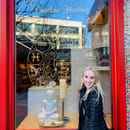Actress, screenwriter, and filmmaker Greta Gerwig revisited Louisa May Alcott’s Little Women and directed a groundbreaking, modern adaption. The story proves itself to be more applicable to modern women through Gerwig’s and the production’s thoughtful tweaks.
This is not the only Oscar-nominated film on Gerwig’s resume. Before her retelling of the classic tale, she directed the coming-of-age film Lady Bird, also starring Saoirse Ronan. Like Alcott’s novel, Lady Bird was reportedly inspired by fragments of Gerwig’s real life. While both films demonstrate Gerwig’s artistry in filmmaking, her adeptness at delivering a version both honoring and altering the original Little Women is quite telling of her artistic vision. The most obvious difference becomes apparent in that the modern recreation revolves around the book Little Women’s own making, presenting the tale as a visually pleasing and emotionally gripping reproduction of Alcott’s experience as a woman in the publishing industry.
There have been twelve renditions of the classic thus far, including five films. Gerwig’s film is attractive at first glance, for it stars a “dream cast” consisting of rising star Saoirse Ronan as Jo, Timothee Chalamet as “Laurie,” Laura Dern as “Marmie,” Emma Watson as Meg, Florence Pugh as Amy, Eliza Scanlan as Beth, and Meryl Streep as Aunt March. The recent adaptation certainly remains faithful to the original plot and stays loyal to the characters. Gerwig manages to maintain hold of what makes the classic so compelling, which is the heavy reliance on characterization but in a feminist context. How Gerwig captures these individual stories reveals the applicability of their struggles to modern times.
Whether the reinterpretation of the characters was intentional, Gerwig puts it simply in an interview with Wrapit: “It was like completely modern and pressing and strange and relevant, and it was about exactly what my central interests are: authorship, ownership, women, money and how that all intersects.”
And by merging these interests, Gerwig draws attention to characterization, with an emphasis on Jo and Amy’s careers. The film focuses primarily on the eldest daughter Jo’s struggle as an uninspired writer until she recognizes the beautiful and riveting story unfolding in front of her, and eventually publishes the title Little Women. It highlights the pitfalls of rejection and the excruciating efforts of women in the book publishing industry during the 1800s. Unlike past adaptations that featured different actresses playing the role of young and older Amy, Florence Pugh portrayed both versions. What is remarkable is Pugh’s ability to convincingly transition between disparate versions of Amy.
Although insisted as a secondary character in past versions, this Amy played by Pugh evolves from a vivacious, sometimes immature and petty sister who pines after Laurie and wants companionship with Jo, who does not always reciprocate. Her ambitions towards art emerge in her youth, as she openly exclaims her vision of her future even if her sisters paid her no mind. From the perspective of her later years studying art in Paris, Amy is all the more reserved and hesitant to become involved with Laurie. Although Amy’s childlike spirit seems to have been suppressed in her adulthood, she is nonetheless expressive and grounded and stays true to herself. This dynamic in her character was undeniably the most interesting aspect of the film in my opinion.
The film also tackles the controversy of marriage from a fresh perspective but does not depict an unrealistic story that is unhinged from the novel or 19th century. Contradicting their past beliefs, Amy’s inevitable marriage to Laurie after reuniting in Paris by chance still occurs, as well as Jo’s realization of her love for Bhaer. Despite these endings, a striking moment in the film was when Amy acknowledges marriage as an “economic proposition.” It was considered quite daring, and maybe even innovative, to regard the tradition of marriage as oftentimes a financial exchange rather than a union based upon love. And complimentary to Amy’s experience, Jo fears upon Laurie’s informal proposal to her that marriage will cage her free spirit and inhibit her from chasing her dream. Even though the modern take plays with this notion, it does not necessarily bash it. A particularly important scene with Meg and Jo epitomized the fine line between marriage as a means of elevating status and solidifying a relationship.
While Jo and Amy stray away from marriage as an economic proposition or imprisonment of spirit, it is clear that Meg intends from a young age to marry someone to help her family. Jo urges Meg to run away with her leading up to Meg’s marriage, insisting that she will grow bored of him (John Brooke) and that their companionship as sisters will never cease to be interesting. Meg returns, “Just because my dreams are different from yours doesn’t mean they’re unimportant.” The storyline of the ambitious writer and painter was essential to the film, though the relevance of Meg’s situation in sacrificing “marrying up” in hopes of satisfying their wealthy Aunt March and bringing their family up in status and wealth was influential in itself. This moment was particularly thought-provoking, as it calls into question how marriage is perceived as unfeminist and unambitious in modern times.
The development of these characters distinguished Gerwig’s rendition from those of others, and her approach to the timeline was a formidable attribute of the film. It was not strictly chronological and included constant shifts from their youth where they are living in the same household in Concord, Massachusetts, and then adult years separated by life circumstances. The picture begins in the second (later) timeline with Jo’s grappling with a stubborn, evidently sexist publisher, and adamantly writing a collection of stories that fail to impress her counterpart Bhaer. It seamlessly jumps to seven years earlier, with Jo gathered with her sisters on the Christmas holiday, followed by meeting her best friend Laurie. In a sequence of familiar scenes, it shows the little women as they meet the threshold of adulthood, as Jo departs to write and Amy to study art, Beth’s declining health, and Meg’s marriage to someone deemed unsuitable in terms of financial needs.
Although it may seem easy to get lost in the plot’s complexities, the warmer tones of the childhood memories serve to represent the innocence lost in their later years. While their childhood aspirations become realities in the second timeline, the story centers around the impending illness of Beth. The two timelines eventually meet at this moment, as Beth’s experience with scarlet fever when she was younger parallels her untimely, heartbreaking death. At this point, the story comes full circle, as they reunite in the tragic event after the slowly diminished the defining bonds of their childhood.
After finishing the film the day after its release on December 26th, I felt moved by Gerwig’s unexpected minor changes that weaved together into something of sentiment and innovation. I cannot wait to see what film Gerwig makes next, whether it be an adaptation or derived from her own experiences.



